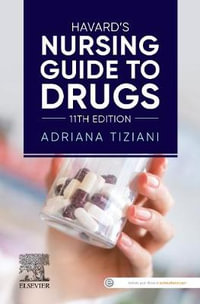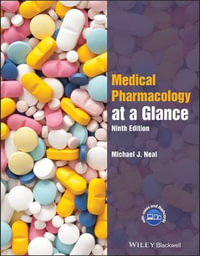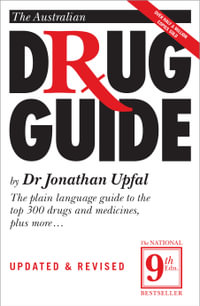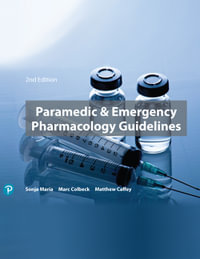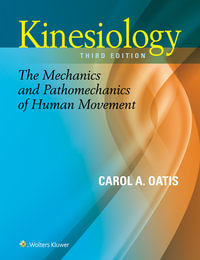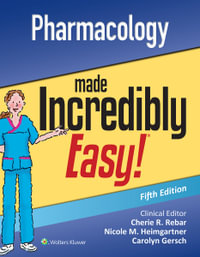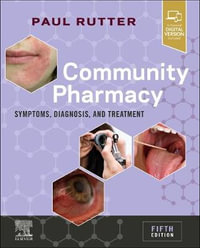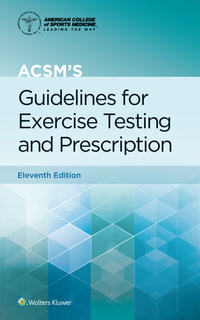
Instant online reading.
Don't wait for delivery!
Go digital and save!
Retrosynthesis in the Manufacture of Generic Drugs
Selected Case Studies
By: Pedro Paulo Santos, William Heggie
Hardcover | 9 November 2020 | Edition Number 1
At a Glance
432 Pages
297.0 x 210.0 x 3.04
Hardcover
$470.25
or 4 interest-free payments of $117.56 with
orAims to ship in 15 to 25 business days
Offers a compendium of information on retrosynthesis and process chemistry, featuring innovative "reaction maps" showing synthetic routes of some widely used drugs
This book illustrates how the retrosynthetic tool is applied in the Pharmaceutical Industry. It considers and evaluates the many viable synthetic routes that can be used by practicing industrialists, guiding readers through the various steps that lead to the "best" processes and the limits encountered if these are put into practice on an industrial scale of seven key Active Pharmaceutical Ingredient (API). It presents an evaluation of the potential each process has for implementation, before merging the two points of view—of retrosynthesis and process chemistry—in order to show how retrosynthetic analysis assists in selecting the most efficient route for an industrial synthesis of a particular compound whilst giving insight into the industrial process. The book also uses some key concepts used by process chemists to improve efficiency to indicate the best route to select.
Each chapter in Retrosynthesis in the Manufacture of Generic Drugs Selected Case Studies is dedicated to one drug, with each containing information on: worldwide sales and patent status of the Active Pharmaceutical Ingredient (API); structure analysis and general retrosynthetic strategy of the API; first reported synthesis; critical analysis of the processes which have been developed and comparison of the synthetic routes; lessons learned; reaction conditions for Schemes A to X; chemical "highlights" on key reactions used during the synthesis; and references. Drugs covered include: Gabapentin, Clopidogrel, Citalopram and Escitalopram, Sitagliptin, Ezetimibe, Montelukast, and Oseltamivir.
- Show how the retrosynthetic tool is used by the Pharmaceutical Industry
- Fills a gap for a book where retrosynthetic analysis is systematically applied to active pharmaceutical ingredients (APIs)
- Features analyses and methodologies that aid readers in uncovering practical synthetic routes to other drug substances, whether they be NCEs (New Chemical Entities) or generic APIs (Active Pharmaceutical Ingredients)
- Presents information from both the patent and academic literature for those who wish to use as a basis for further study and thought
- Features the use of "reaction maps" which display several synthetic processes in the same scheme, and which allow easy comparisons of different routes that give the same molecule or intermediate
Retrosynthesis in the Manufacture of Generic Drugs Selected Case Studies is an ideal book for researchers and advanced students in organic synthetic chemistry and process chemistry. It will also be of great benefit to practitioners in the pharmaceutical industry, particularly new starters, and those new to process chemistry.
Preface xv
A note about the book and its use xvii
Abbreviations xix
1 Introduction 1
2 Gabapentin 5
2.1 Worldwide sales and patent status 6
2.2 Gabapentin structure and general retrosynthetic strategy 7
2.2.1 Using the primary amine for retrosynthesis 7
2.2.2 Rearrangement as a key synthetic step: taking advantage of symmetrical intermediates 8
2.2.3 Avoiding the rearrangement and obtaining the amine by a reduction step 10
2.2.4 Disconnecting only one carbon chain from the cyclohexane ring 10
2.2.5 Using an aromatic ring to produce the saturated cyclohexane ring 11
2.3 The first reported synthesis of gabapentin 13
2.4 The evolution of the chemical synthesis of gabapentin 14
2.4.1 Initial development of synthetic routes to Gabapentin using a rearrangement step 14
2.4.2 Routes to the spiro-anhydride or spiro-imide intermediates 16
2.4.3 Synthetic routes of Gabapentin using a one carbon atom nucleophile 18
2.4.4 The 1,4-dicarbonyl intermediate routes 23
2.4.5 Synthetic processes based on a Birch reduction 25
2.4.6 Re-visiting the rearrangement as a key step 26
2.4.7 Other synthetic routes 26
2.4.8 Purifying the product 27
2.5 Strategy comparison and conclusions 28
2.6 Lessons from the gabapentin case 29
2.7 Reaction conditions for schemes A to D 31
2.8 References 34
3 Clopidogrel 39
3.1 Worldwide sales and patent status 40
3.2 Clopidogrel structure and general retrosynthetic strategy 41
3.2.1 Chirality and Clopidogrel 41
3.2.2 Retrosynthetic analysis 44
3.3 The first reported synthesis of Clopidogrel 49
3.4 The evolution of chemical synthesis of Clopidogrel 50
3.4.1 Synthetic routes using a resolution step 50
3.4.2 Asymmetric synthesis in Clopidogrel production 66
3.4.3 Other synthetic processes 67
3.4.4 Synthesis of the Thiophene building block 69
3.5 Strategy comparison and conclusions 71
3.6 Lessons from the Clopidogrel case 73
3.7 Reaction conditions for schemes C to J 73
3.8 References 78
4 Citalopram And Escitalopram 85
4.1 Worldwide sales and patent status 86
4.2 Escitalopram/Citalopram structure 87
4.3 Retrosynthetic analysis of Citalopram 88
4.3.1 Disconnection of the propylamine side chain 88
4.3.2 The aromatic nitrile group 89
4.3.3 Retrosynthesis of the trisubstituted aromatic intermediate 89
4.4 Escitalopram retrosynthesis 93
4.5 The first reported synthesis of Citalopram 95
4.6 The evolution of chemical synthesis of Citalopram 96
4.7 A quick glimpse of Escitalopram 97
4.8 The two Grignard phase in Citalopram synthesis 98
4.8.1 Two Grignard route using 5-bromophthalide as starting material 98
4.8.2 Two Grignard route using 5-cyanophthalide as starting material 102
4.8.3 Coupling the hydrofuran ring formation with the second Grignard reaction 103
4.8.4 A two Grignard route not using 3-dimethylamino propyl Grignard 103
4.8.5 Phthalide synthesis 104
4.8.6 The non-Grignard C3 nucleophilic route 105
4.9 The phthalane route – alkylation of a phthalane with an electrophilic side chain 107
4.10 Other synthetic routes to Citalopram 112
4.11 Strategy comparison and conclusions for the synthesis of Citalopram 113
4.12 The evolution of Escitalopram synthesis 113
4.12.1 The chiral switch 113
4.12.2 The first process for Escitalopram 113
4.12.3 Diol as a key intermediate in Escitalopram synthesis 115
4.12.4 Resolution of Citalopram and desmethyl analogues 119
4.12.5 Recovery of DPTTA 120
4.12.6 Recycling of unwanted R-isomers 121
4.12.7 Key Diels-Alder cycloaddition in the synthesis of Escitalopram 122
4.12.8 Escitalopram by asymmetric synthesis 123
4.13 Best processes for Escitalopram 126
4.14 Lessons from the Citalopram/Escitalopram case 127
4.15 Reaction conditions for schemes A to H 128
4.16 References 135
5 Sitagliptin 141
5.1 Worldwide sales and patent status 142
5.2 Sitagliptin structure and general retrosynthetic analysis 143
5.2.1 Disconnecting the heterocycle first 143
5.2.2 Retrosynthetic analysis starting by transformation of the chiral amine 146
5.2.3 Retrosynthetic analysis starting from haloaromatic ring 147
5.2.4 Retrosynthesis analysis summary and most efficient routes 147
5.3 The first reported Sitagliptin synthesis 149
5.4 The search for an industrial synthesis for Sitagliptin 149
5.4.1 Coupling the triazolopyrazine heterocycle at the end of the synthesis: producing a key chiral β-amino acid intermediate 151
5.4.2 Producing the chiral amine during the final stages of the synthesis 168
5.4.3 Synthesis of Sitagliptin by attaching the 2,4,5-trifluorophenyl ring at the end of the synthesis 179
5.4.4 Triazolopyrazine synthesis 181
5.5 Strategy comparison and conclusions 184
5.5.1 Main strategies for asymmetric synthesis 184
5.5.2 The relative positions of the asymmetric step and the amide forming coupling reaction in route selection 186
5.5.3 Preferred routes for the synthesis of Sitagliptin 187
5.6 Lessons from the Sitagliptin case 189
5.7 Reaction conditions for schemes A to J 191
5.8 References 200
6 Ezetimibe 207
6.1 Worldwide sales and patent status 208
6.2 Ezetimibe structure and general retrosynthetic analysis 209
6.2.1 The azetidin-2-one ring formation 210
6.2.2 Key structural features for the retrosynthesis 212
6.2.3 Retrosynthesis using the Staudinger cycloaddition for the azetidin-2-one synthesis 212
6.2.4 Retrosynthesis using the Kinugasa reaction to produce the azetidin-2-one 213
6.2.5 Retrosynthesis using a N to C2 ring closure to produce the azetidin-2-one 214
6.2.6 The (S)-hydroxyl benzylic group of Ezetimibe 217
6.2.7 Summary of the retrosynthesis analysis 218
6.3 The first Ezetimibe syntheses 219
6.4 The search for an industrial synthesis of Ezetimibe 221
6.4.1 The synthesis of the C5 chain intermediates and the imines 221
6.4.2 Using the Staudinger reaction in the azetedin-2-one ring formation 224
6.4.3 The Wacker oxidation route 224
6.4.4 The search for a selective β-lactam formation 227
6.4.5 Using Kinugasa cycloaddition 227
6.4.6 N-C2 ring closing strategy and the build-up sequence 230
6.4.7 N-C2 ring closure strategy: late attachment of the p-fluoroaromatic ring 231
6.4.8 N-C2 ring closure strategy: attaching the p-fluoroaromatic ring at the beginning of the synthesis 236
6.4.9 N-C2 ring closing strategy: implementing the reduction at the beginning of the route 243
6.4.10 Ezetimibe by alkylation of a C3 unsubstituted β-lactam 252
6.4.11 Other β-lactam ring formations by N-C4 cyclization 254
6.5 Comparison of strategies and conclusions 255
6.6 The best syntheses 259
6.7 Lessons from the Ezetimibe case 261
6.8 Reaction conditions for schemes A to M 262
6.9 References 269
7 Montelukast 275
7.1 Worldwide sales and patent status 275
7.2 Montelukast structure and general retrosynthetic analysis 277
7.2.1 Chirality issues 277
7.2.2 The thiol side chain and the enantioselectivity of the synthetic process 278
7.2.3 Retrosynthetic analysis of the thiol side chain 279
7.3 Retrosynthetic outline 279
7.4 The first reported Montelukast synthesis 282
7.5 The evolution of industrial chemical syntheses of Montelukast 283
7.5.1 Processes to produce keto-ester intermediate 286
7.5.2 Processes to convert the keto-ester intermediate to Montelukast 286
7.5.3 Montelukast synthesis using an incomplete thiol for the SN2 displacement 290
7.5.4 Montelukast synthesis using a Heck reaction as a key step 292
7.5.5 Montelukast synthesis using a carbonyl olefination reaction as a key step 294
7.5.6 Montelukast synthesis using a Michael addition as a key step 297
7.6 Synthesis of the thiol side chain 297
7.6.1 Electrophilic side chain reactants 301
7.7 Strategy comparison and conclusions 301
7.8 Lessons from the Montelukast case 305
7.9 Reaction conditions for schemes A to F 307
7.10 References 312
8 Oseltamivir 319
8.1 Worldwide sales and patents status 320
8.2 Oseltamivir structure and general retrosynthetic analysis 321
8.2.1 Starting material targeted retrosynthesis 322
8.2.2 Retrosynthetic strategies of the Oseltamivir cyclohexene ring 324
8.2.3 Retrosynthetic analysis summary 330
8.3 The first reported Oseltamivir synthesis 331
8.4 Routes from shikimic acid or quinic acid 332
8.4.1 First developments from shikimic acid or quinic acid 333
8.4.2 Azide free routes 336
8.4.3 Other routes from (–)-shikimic acid 338
8.5 The supply problem 342
8.5.1 Quinic and shikimic acid supply 342
8.6 First non-shikimic or quinic acid synthetic routes 343
8.6.1 The Diels-Alder furan approach 343
8.6.2 Oseltamivir by total hydrogenation of an aromatic ring 343
8.7 Synthesis of Oseltamivir from cyclohexadiene derivatives 344
8.7.1 Meso aziridines desymmetrization routes 344
8.7.2 Using iron diene carbonyl complexes 345
8.7.3 From cyclohexa-3,5-diene-1,2-diol derivatives 347
8.8 Building the carboxylic ring of Oseltamivir by a Diels-Alder reaction 350
8.8.1 Using a [4+2] cycloaddition to produce a trisubstituted six-membered ring adduct 350
8.8.2 Using a [4+2] cycloaddition to produce a monosubstituted six-membered ring adduct 356
8.8.3 Alternative syntheses for the Corey intermediate 356
8.9 Oseltamivir ring by a [3,3] sigmatropic rearrangement 360
8.10 Oseltamivir synthesis by a Michael addition-Horner-Wadsworth-Emmons cascade sequence 360
8.11 Aldol type condensations as key ring-forming step 365
8.12 Metathesis as key-ring forming step 365
8.13 Strategy comparison and conclusions 374
8.14 Lessons from the Oseltamivir case 378
8.15 Reaction conditions for schemes B to R 378
8.16 References 390
9 A Final Word 395
ISBN: 9781119155539
ISBN-10: 1119155533
Published: 9th November 2020
Format: Hardcover
Language: English
Number of Pages: 432
Audience: Professional and Scholarly
Publisher: John Wiley & Sons (UK)
Country of Publication: US
Edition Number: 1
Dimensions (cm): 297.0 x 210.0 x 3.04
Weight (kg): 1.28
Shipping
| Standard Shipping | Express Shipping | |
|---|---|---|
| Metro postcodes: | $9.99 | $14.95 |
| Regional postcodes: | $9.99 | $14.95 |
| Rural postcodes: | $9.99 | $14.95 |
How to return your order
At Booktopia, we offer hassle-free returns in accordance with our returns policy. If you wish to return an item, please get in touch with Booktopia Customer Care.
Additional postage charges may be applicable.
Defective items
If there is a problem with any of the items received for your order then the Booktopia Customer Care team is ready to assist you.
For more info please visit our Help Centre.
You Can Find This Book In
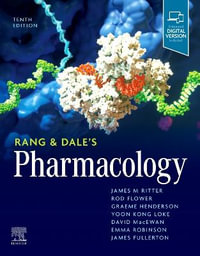
FREE SHIPPING
RRP $120.95
$90.00
OFF
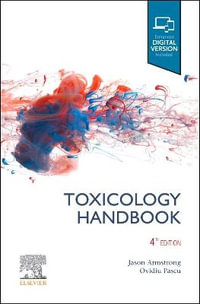
FREE SHIPPING
Paperback
RRP $123.95
$80.00
OFF
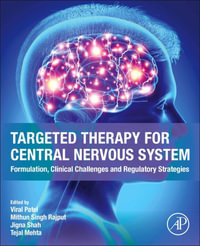
Targeted Therapy for Central Nervous System
Formulation, Clinical Challenges and Regulatory Strategies
Paperback
RRP $352.95
$312.95
OFF
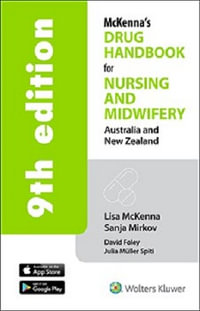
Australia and New Zealand McKenna's Drug Handbook for Nursing and Midwifery
Australia and New Zealand 9th edition
Paperback
RRP $87.95
$74.75
OFF
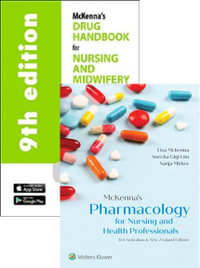
Package of McKenna's Pharmacology 3e and Drug Handbook for Nursing and Midwifery 9e Australia & New Zealand Edition
Multi-Item Pack
RRP $164.95
$130.95
OFF

